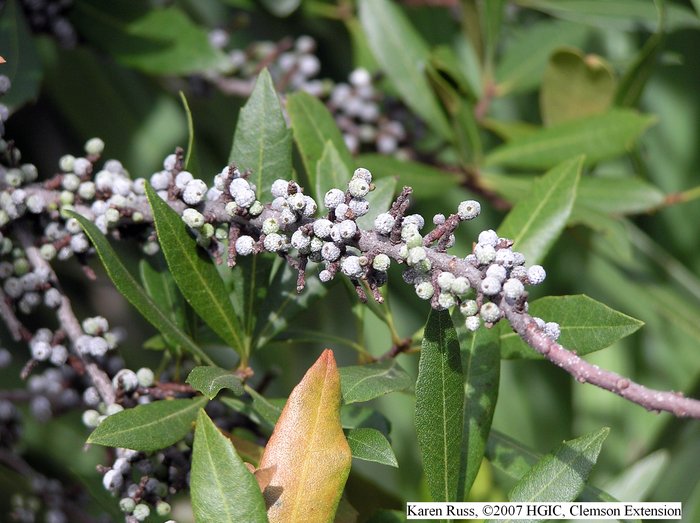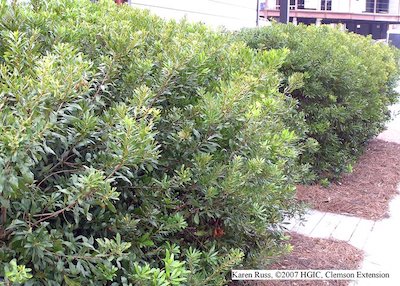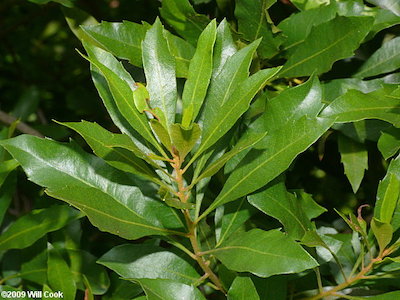Southern Wax Myrtle: Versatile, Native and Evergreen
By Gretchen Spencer, Fairfax Master Gardener

Waxmyrtle berries
Are you looking for a native evergreen shrub for your yard or landscape? If so, you might consider the southern wax myrtle, Myrica cerifera, previously known as Morella cerifera. This lovely, versatile light-green shrub has many uses in the landscape and is adaptable to a variety of growing conditions. I was unfamiliar with this shrub (some articles refer to it as a small tree) until a landscape-architect neighbor of mine suggested it to me. She has a hedge of southern wax myrtles bordering her front yard. I have observed them over the last few years, and I can confirm that they provide good screening, interesting multi-stemmed form and the signature berries and leaves that emit a fragrant bayberry scent when crushed. In fact, other common names for this shrub include bayberry, candleberry and tallow shrub. As you have probably guessed, the fruit of this species have been used to make bayberry candles, soaps and sealing wax.
The southern wax myrtle’s native habitat includes southern New Jersey to Central America and west to eastern Oklahoma and eastern Texas. It is frequently found growing along marshes and in forests and swamps as well as in pure sand. In fact, it thrives in the sandy beaches from New Jersey to the Florida Keys. Not surprisingly, wax myrtle plants are extremely tolerant of salt sprays and wind. This rapidly growing shrub is adaptable in medium to wet soils and will tolerate dry soils once established. Another interesting fact about this plant is that it fixes nitrogen in the soil, which allows it to survive in diverse soil conditions. Additionally, it is deer resistant.

Waxmyrtle as hedge
The southern wax myrtle grows from 10 to 20 feet tall and 8 to 10 feet wide. It is somewhat irregular in shape, but this lends informality to the landscape, making it appropriate for woodland gardens or less formal hedges. As it spreads by root suckers, it can form dense colonies. Its slender, light-green, glossy leaves are 1 ½ to 3 inches long and finely toothed at the apex or narrow end. The leaves have glands on both surfaces that give off the spicy fragrance. The small male and female flowers are usually found on separate plants. A male plant is needed for good berry production. The small, round waxy fruit is found on female plants in clusters of two to six hugging the stem. The clusters of silvery drupes give the branches a bejeweled appearance.

Evergreen leaves
As mentioned above, the southern wax myrtle is a versatile plant and will succeed in a variety of soil conditions. Tough and durable, it is winter hardy from Zones 7 to 10. (Northern Virginia is in Zone 7.) In extreme cold, its leaves can turn brown, but this does not injure the plant stems. It can be planted in full sun to part shade. Pruning is recommended to keep the plant to its desired size. Wax myrtle plants do not have any serious insect or disease problems, although they can suffer from leaf anthracnose or leaf mosaic. However, the plant is a fire risk due to the aromatic compounds contained in its leaves, stems and branches. It should not be planted too close to a home. Plants may also be rated by their flammability. The southern wax myrtle is similar to the northern bayberry, but the southern species is heat loving.
The southern wax myrtle provides winter cover for birds and small mammals. Its flowers provide a good source of nectar for bees and butterflies, and the berries are enjoyed by birds. It is also the host plant for the red-banded hairstreak butterfly. Its drupes are used to make bayberry candles, soap and sealing wax. Wax myrtle shrubs can be used for screening, grown in woodland gardens or shrub borders in wet or shady sites. It can also be grown on banks to control erosion or planted near streets that may be salted in winter. By removing the lower branches, the wax myrtle can be shaped into a small tree. There are many compact forms such as ‘Don’s Dwarf’ that grows to 3 to 5 feet tall and wide. Another cultivar, ‘Fairfax,’ has dense foliage and grows 6 to 8 feet high. Given its versatility, toughness and the many benefits it provides, there is certainly a southern wax myrtle to meet your landscaping needs.
Resources
Myrica cerifera, North Carolina State University Extension Gardener Plant Toolbox
Waxmyrtle, Clemson Cooperative Extension, Home and Garden Information
Morella cerifera, Missouri Botanical Garden
Dirr’s Encyclopedia of Trees and Shrubs, by Michael A. Dirr